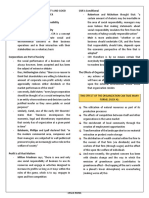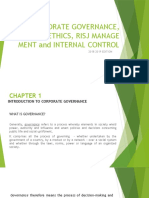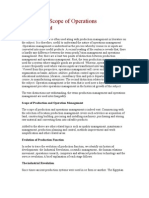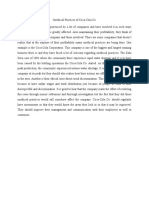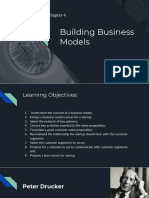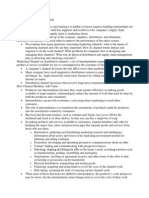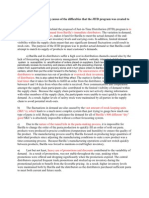0 ratings0% found this document useful (0 votes)
866 viewsWhat Is Retailing, and Why Is It Undergoing So Much Change Today?
What Is Retailing, and Why Is It Undergoing So Much Change Today?
Uploaded by
Deepak Kumar SubudhiRetailing involves the final activities needed to place merchandise into the hands of consumers or provide services directly to consumers. Retailing is undergoing significant changes today due to the rise of e-commerce/online retailing ("e-tailing"), increased price competition, demographic shifts, and changes in store sizes. E-tailing has given consumers more power and control over the shopping experience by providing more pricing information online. Retailers are experimenting with both in-store and online strategies to adapt to these changes in the industry and rising consumer expectations.
Copyright:
© All Rights Reserved
Available Formats
Download as PPTX, PDF, TXT or read online from Scribd
What Is Retailing, and Why Is It Undergoing So Much Change Today?
What Is Retailing, and Why Is It Undergoing So Much Change Today?
Uploaded by
Deepak Kumar Subudhi0 ratings0% found this document useful (0 votes)
866 views40 pagesRetailing involves the final activities needed to place merchandise into the hands of consumers or provide services directly to consumers. Retailing is undergoing significant changes today due to the rise of e-commerce/online retailing ("e-tailing"), increased price competition, demographic shifts, and changes in store sizes. E-tailing has given consumers more power and control over the shopping experience by providing more pricing information online. Retailers are experimenting with both in-store and online strategies to adapt to these changes in the industry and rising consumer expectations.
Original Description:
hii
Original Title
RMM1
Copyright
© © All Rights Reserved
Available Formats
PPTX, PDF, TXT or read online from Scribd
Share this document
Did you find this document useful?
Is this content inappropriate?
Retailing involves the final activities needed to place merchandise into the hands of consumers or provide services directly to consumers. Retailing is undergoing significant changes today due to the rise of e-commerce/online retailing ("e-tailing"), increased price competition, demographic shifts, and changes in store sizes. E-tailing has given consumers more power and control over the shopping experience by providing more pricing information online. Retailers are experimenting with both in-store and online strategies to adapt to these changes in the industry and rising consumer expectations.
Copyright:
© All Rights Reserved
Available Formats
Download as PPTX, PDF, TXT or read online from Scribd
Download as pptx, pdf, or txt
0 ratings0% found this document useful (0 votes)
866 views40 pagesWhat Is Retailing, and Why Is It Undergoing So Much Change Today?
What Is Retailing, and Why Is It Undergoing So Much Change Today?
Uploaded by
Deepak Kumar SubudhiRetailing involves the final activities needed to place merchandise into the hands of consumers or provide services directly to consumers. Retailing is undergoing significant changes today due to the rise of e-commerce/online retailing ("e-tailing"), increased price competition, demographic shifts, and changes in store sizes. E-tailing has given consumers more power and control over the shopping experience by providing more pricing information online. Retailers are experimenting with both in-store and online strategies to adapt to these changes in the industry and rising consumer expectations.
Copyright:
© All Rights Reserved
Available Formats
Download as PPTX, PDF, TXT or read online from Scribd
Download as pptx, pdf, or txt
You are on page 1of 40
What is Retailing, and Why is it
Undergoing so Much Change Today?
Retailing - Consists of the final activities and steps needed to place
merchandise made elsewhere into the hands of the consumer or to
provide services to the consumer.
Any firm that sells a product or provides a service to the final
consumer is said to be performing the retailing function.
LO 1
What is Retailing, and Why is it
Undergoing so Much Change Today?
E-tailing
Price competition
Demographic shifts
Store size
LO 1
E-tailing
The great unknown for retail managers will be the ultimate role of the
Internet.
Bricks-and-mortar retailers - Operate out of a physical building.
With the growth of the web 2.0, the Internet has become much more
interactive and social in nature. This has important implications for
retailers.
LO 1
E-tailing
To combat e-tailing, bricks-and-mortar retailers must give their
customers more control over the shopping experience.
LO 1
E-tailing
E-tailing has caused a shift in power between retailers and
consumers.
Traditionally, the retailers control over pricing information provided them the
upper hand in most transactions.
The information dissemination capabilities of the Internet are making
consumers better informed and thus increasing their power when transacting
and negotiating with retailers.
LO 1
E-tailing
Retailers must keep experimenting with various strategies, both in-
store and online because the next generation of technology will
change the consumers expectations of what they demand from their
retailers.
LO 1
Price Competition
Sam Walton forever changed the face of retailing by realizing that
most of any products cost gets added after the item is produced.
Walton made a major commitment to computerizing Wal-Mart as a
means to reduce expenses.
Costco, a retailer, seeks to boost store traffic by getting shoppers to
come in for a super, low price on key products.
LO 1
Demographic Shifts
Significant changes in retailing over the past decade have resulted
from changing demographic factors such as:
The fluctuating birthrate, the growing importance of the 70 million
Generation Y consumers.
The move of Generation X into middle age.
The beginning movement of the baby boomer generation into retirement.
The increasing number of immigrants.
LO 1
Demographic Shifts
Successful retailers must:
become more service-oriented
offer better value in price and quality
be more promotion-oriented, and
be better attuned to their customers needs.
LO 1
Demographic Shifts
Profit growth must come by either:
increasing same-store sales at the expense of the competitions market share
or
by reducing expenses without reducing services to the point of losing
customers.
LO 1
Demographic Shifts
Same-store sales - Compares an individual stores sales to its sales for
the same month in the previous year.
Market share - Retailers total sales divided by total market sales.
LO 1
Store Size
As stores increase in size the retailer often employs a scrambled
merchandising strategy.
Scrambled merchandising - Exists when a retailer handles many
different and unrelated items.
It is the result of the pressure being placed on many retailers to increase
profits.
LO 1
Store Size
Retailers realized that having supersized stores increased several
major costs:
Rent
Inventory costs, and
Labor costs.
Two retail formats that have recently seen a significant decrease in
average store size and a decrease in number of stores are:
Department stores and
Category killers.
LO 1
Store Size
Category killer - Retailer that carries such a large amount of
merchandise in a single category at such good prices that it makes it
impossible for the customers to walk out without purchasing what
they need, thus killing the competition.
LO 1
Exhibit 1.1 - External Environmental
Forces Confronting Retail Firms
LO 1
Categorizing Retailers
Census bureau
Number of outlets
Margin versus Turnover
Location
Size
LO 2
Census Bureau
The U.S. Bureau of the Census, for purposes of conducting the Census
of Retail Trade, classifies all retailers using three-digit North American
Industry Classification System (NAICS) codes.
Shortcoming of using the NAICS codes is that they do not reflect all
retail activity.
LO 2
Exhibit 1.2 - The Five Methods Used to
Categorize Retailers
LO 2
Number of Outlets
Retailers with several units are a stronger competitive threat because
they can:
Spread many fixed costs over a larger number of stores.
Achieve economies in purchasing.
Advantages of single-unit retailers:
They have harder-working, more motivated employees.
They can focus and tailor their efforts and merchandise in one trade area.
LO 2
Number of Outlets
Standard stock list - Merchandising method in which all stores in a
retail chain stock the same merchandise.
Optimal stock list - Merchandising method in which each store in a
retail chain is given flexibility to adjust its merchandise mix to local
tastes and demands.
LO 2
Number of Outlets
Channel advisor or Channel captain - Institution in the marketing
channel who is able to plan for and get other channel institutions to
engage in activities they might not otherwise engage in.
Examples could be manufacturer, wholesaler, broker, or retailer.
Large store retailers are often able to perform the role of channel captain.
LO 2
Number of Outlets
Private label branding - Occurs when a retailer develops its own
brand name and contracts with a manufacturer to produce the
merchandise with the retailers brand on it instead of the
manufacturers name.
Also called store branding.
LO 2
Number of Outlets
The major shortcoming of using the number of outlets scheme for
classifying retailers is that it addresses only traditional bricks & mortar
retailers.
LO 2
Margins Versus Turnover
Gross margin percentage - Gross margin divided by net sales or what
percent of each sales dollar is gross margin.
Gross margin - Net sales minus the cost of goods sold.
Operating expenses - Expenses the retailer incurs in running the
business other than the cost of the merchandise.
LO 2
Margins Versus Turnover
Inventory turnover - The number of times per year, on average, that a
retailer sells its inventory.
High-performance retailers - Produce financial results substantially
superior to the industry average.
Low-margin/low turnover retailer - Operates on a low gross margin
percentage and a low rate of inventory turnover.
LO 2
Margins Versus Turnover
Low-margin/high turnover retailer - Operates on a low gross margin
percentage and a high rate of inventory turnover.
High-margin/low turnover retailer - Operates on a high gross margin
percentage and a low rate of inventory turnover.
LO 2
Margins Versus Turnover
Clicks & mortar retailers - Sell both online and via physical stores.
High-margin/high turnover retailer - Operates on a high gross margin
percentage and a high rate of inventory turnover.
LO 2
Low
Turnover
High
Turnover
High Margin
Low Margin
Excellent position
to withstand a
competitive attack
Least able to
withstand a
competitive attack
Margins Versus Turnover
LO 2
Location
Retailers are now aware that opportunities exist in new non-
traditional retail areas.
Retailers are reaching out for alternative retail sites, rather than
simply renovating the existing stores.
Today, the most significant of the new nontraditional shopping
locations could be the one which combines culture with
entertainment or shopping.
LO 2
Size
The reason for classifying by size is that the operating performance of
retailers tends to vary according to size.
With advances in technology, using classification of size is unclear.
LO 2
A Retailing Career
Career path
Common questions about a retailing career
Prerequisites for success
LO 3
Exhibit 1.4 - Retailing-Two Career Paths
LO 3
Career Path
Store management - The retailing career path that involves
responsibility for:
Selecting
Training
Evaluating personnel
In-store promotions
Displays
Customer service
Building maintenance, and
Security.
LO 3
Career Path
Buying - The retailing career path whereby one uses quantitative
tools to develop appropriate buying plans for the stores merchandise
lines.
LO 3
Common Questions About a Retailing
Career
Salary
Career progression
Geographic mobility
Women in retailing
Societal perspective
LO 3
Prerequisites for Success
Hard work
Analytical skills
Creativity
Decisiveness
Flexibility
Initiative
Leadership
Organization
Risk taking
Stress tolerance
Perseverance
Enthusiasm
LO 3
The Study and Practice of Retailing
Analytical method
Creative method
A two-pronged approach
A proposed orientation
LO 4
The Study and Practice of Retailing
Analytical Method
Manager is finder and
investigator of facts.
Creative Method
Manager is conceptual
and very imaginative.
Two-Pronged Method
Manager who employs both
approaches.
LO 4
A Proposed Orientation
It has four major orientations:
Environmental - allows the retailers to anticipate and adapt continuously to
external forces in the environment.
Management planning - helps the retailers to adapt systematically to a
changing environment.
Profit - all retail decisions will have an effect on the firms financial
performance.
Decision making - allows the retailers to focus on the need to collect and
analyze data to make intelligent retail decisions.
LO 4
Exhibit 1.5 - The Importance of Proactive
Planning
LO 4
You might also like
- Single Company QuizDocument3 pagesSingle Company QuizShanthan AkkeraNo ratings yet
- Chapter - 1: Introduction To Cost Accounting: I. Multiple Choice QuestionsDocument35 pagesChapter - 1: Introduction To Cost Accounting: I. Multiple Choice QuestionsJay Patel67% (12)
- Working Capital Management at Bharat Coking Coal Limite1Document47 pagesWorking Capital Management at Bharat Coking Coal Limite1Avinandan Kumar100% (1)
- CSR Midterm ReviewerDocument23 pagesCSR Midterm ReviewerCriza Riene SualogNo ratings yet
- 2Document9 pages2Murali GopalanNo ratings yet
- Identify and Meet A Market Need: 4.1 Identify Your Market 4.2 Research The Market 4.3 Know Your CompetitionDocument48 pagesIdentify and Meet A Market Need: 4.1 Identify Your Market 4.2 Research The Market 4.3 Know Your CompetitionSheila Bliss Goc-ongNo ratings yet
- Human Behavior in Organization: "Motivation"Document36 pagesHuman Behavior in Organization: "Motivation"Mark Kevin SantosNo ratings yet
- Swot Analysis of DoveDocument9 pagesSwot Analysis of DoveAbhiyash JainNo ratings yet
- Export Marketing Rationale For Export The Philippine Experience and Getting Started in ExportDocument28 pagesExport Marketing Rationale For Export The Philippine Experience and Getting Started in ExportDesu ChanNo ratings yet
- SAP S - 4HANA MM Mindmap by Benedict YongDocument1 pageSAP S - 4HANA MM Mindmap by Benedict Yongtucu23456100% (1)
- Audit of Expenditure CycleDocument3 pagesAudit of Expenditure CycleFreddie RevillozaNo ratings yet
- Land Bank PresentationDocument38 pagesLand Bank PresentationArold MendizabalNo ratings yet
- Chapter 15 Notes 8th EdDocument14 pagesChapter 15 Notes 8th EdRica Mae M. MamangonNo ratings yet
- Entrepreneurial Management: Kolehiyo NG PantukanDocument32 pagesEntrepreneurial Management: Kolehiyo NG PantukanJasper John PonceNo ratings yet
- Corporate Governance, Business Ethics, Risj Manage Ment and Internal ControlDocument19 pagesCorporate Governance, Business Ethics, Risj Manage Ment and Internal ControlKEYL ENNo ratings yet
- Carrillo-Activity 2Document5 pagesCarrillo-Activity 2Jaztyn Bernadette UruNo ratings yet
- Performance Task 2 - Mini Case AnalysisDocument3 pagesPerformance Task 2 - Mini Case AnalysisPSHNo ratings yet
- Nature and Scope of Operations ManagementDocument2 pagesNature and Scope of Operations ManagementAjay Parmar100% (5)
- 7 Types of Business StrategiesDocument7 pages7 Types of Business StrategiesJaine Pantua GratilNo ratings yet
- Ip Panorama 13 Learning Points JollibeeDocument40 pagesIp Panorama 13 Learning Points JollibeeMariecar CamposNo ratings yet
- CaseStudy SM MEGAMALLSDocument5 pagesCaseStudy SM MEGAMALLSprincess suazoNo ratings yet
- Activity No. 1: Interpreting The 6 P'S: Name: Score: Year/Block: 2 Year/ DateDocument4 pagesActivity No. 1: Interpreting The 6 P'S: Name: Score: Year/Block: 2 Year/ DateJayson Caranza100% (1)
- Module 1 - Lesson 1 - International Business and TradeDocument13 pagesModule 1 - Lesson 1 - International Business and TradeFreddierick Juntilla100% (1)
- Group Decision Support Systems (GDSS)Document12 pagesGroup Decision Support Systems (GDSS)Samuel Bassah100% (1)
- Franchising 2Document10 pagesFranchising 2Leslie Ann Elazegui UntalanNo ratings yet
- Quality Awards and QualityDocument22 pagesQuality Awards and Qualitykhalid7861No ratings yet
- Good Governance (Chapter 4)Document7 pagesGood Governance (Chapter 4)Bobby GuetanNo ratings yet
- PS - MODULE-3 - Building Trust and Sales EthicsDocument22 pagesPS - MODULE-3 - Building Trust and Sales EthicsMarian Rivera DiazNo ratings yet
- Unethical Practices ReflectionDocument2 pagesUnethical Practices ReflectionXytusNo ratings yet
- Participants in International BusinessDocument33 pagesParticipants in International Businesswidedbenmoussa100% (1)
- E-Commerce and Internet MarketingDocument22 pagesE-Commerce and Internet MarketingThought IamNo ratings yet
- Module Unit 1 Ma 326 Hbo BS MaDocument15 pagesModule Unit 1 Ma 326 Hbo BS MaFranciasNo ratings yet
- Survival & Growth of The EnterpriseDocument17 pagesSurvival & Growth of The Enterpriseczars cajayonNo ratings yet
- Module 1 CasesDocument2 pagesModule 1 CasesThea Well RapistaNo ratings yet
- Module 2-Topic 2 - Opportunity SeekingDocument7 pagesModule 2-Topic 2 - Opportunity Seekingmirai desuNo ratings yet
- Chapter 7 PDFDocument22 pagesChapter 7 PDFNgọc Nhung VũNo ratings yet
- The Economic Environment of Retailing: Retail ManagementDocument4 pagesThe Economic Environment of Retailing: Retail ManagementJEMALYN TURINGANNo ratings yet
- Chapter 4 - HRDocument11 pagesChapter 4 - HRMhaii Teradaira50% (2)
- 12 Entrep 6 Developing A Business PlanDocument21 pages12 Entrep 6 Developing A Business PlanRochelle Acala Del RosarioNo ratings yet
- Development and Use of The Generalized BE Formula 2 PDFDocument18 pagesDevelopment and Use of The Generalized BE Formula 2 PDFKueency RoniNo ratings yet
- Facility and Work Design: Operations ManagementDocument28 pagesFacility and Work Design: Operations Managementaquinochristinejamela2005No ratings yet
- Chapter 7: Forms of Small Business Ownership, Registering and OrganizingDocument77 pagesChapter 7: Forms of Small Business Ownership, Registering and OrganizingEmerson CruzNo ratings yet
- Managing Personal Finance: Module of InstructionDocument7 pagesManaging Personal Finance: Module of InstructionCriscel SantiagoNo ratings yet
- Chapter 9: Credit Instruments ObjectivesDocument43 pagesChapter 9: Credit Instruments ObjectiveskatlicNo ratings yet
- CBMEC - Operations Management - PrelimDocument4 pagesCBMEC - Operations Management - Prelimjojie dador100% (1)
- Case Analysis 2Document2 pagesCase Analysis 2Allen Fey De JesusNo ratings yet
- CHAPTER 1 - Franchising History and OverviewDocument9 pagesCHAPTER 1 - Franchising History and OverviewShakey Chavez GayaniloNo ratings yet
- Welcome To The Entrepreneurial World!Document23 pagesWelcome To The Entrepreneurial World!CLAISA POSTRERONo ratings yet
- Chapter 2 Strategic Dimension of QualityDocument19 pagesChapter 2 Strategic Dimension of Qualitymarielboongaling23No ratings yet
- CHAPTER 1 E Commerce and Internet MarketingDocument4 pagesCHAPTER 1 E Commerce and Internet MarketingJessica CerezaNo ratings yet
- Cariel Jean Donsing Bacc 8a Module 1 PDFDocument33 pagesCariel Jean Donsing Bacc 8a Module 1 PDFMary Anne MosedeilNo ratings yet
- Strategy From A Deeper Perspective: Informal Tactics and Schemes inDocument11 pagesStrategy From A Deeper Perspective: Informal Tactics and Schemes inEric100% (1)
- Profitability RatiosDocument2 pagesProfitability RatiosMeghan Kaye LiwenNo ratings yet
- Alaska Milk Corporation PresentationDocument19 pagesAlaska Milk Corporation PresentationRonnie DeanNo ratings yet
- Electronic Commerce and RetailingDocument19 pagesElectronic Commerce and RetailingShaina Trish TaguiamNo ratings yet
- Lesson 4 - Modes of Operation in International Trade and Business - PGDDocument12 pagesLesson 4 - Modes of Operation in International Trade and Business - PGDIrtiSam MahinNo ratings yet
- Entrepreneurs in A Market EconomyDocument12 pagesEntrepreneurs in A Market EconomyAllyza Krizchelle Rosales BukidNo ratings yet
- Chapter - 4 - Building Business ModelsDocument56 pagesChapter - 4 - Building Business ModelsSky CaldeoNo ratings yet
- Entrep Mind Chapter 8Document3 pagesEntrep Mind Chapter 8Yeho ShuaNo ratings yet
- Chapter 12 Marketing ChannelsDocument7 pagesChapter 12 Marketing ChannelsTaylor KalinowskiNo ratings yet
- FranchisingDocument12 pagesFranchisingMaria Teresa Bargayo Hernando0% (1)
- Strategic Management PaperDocument3 pagesStrategic Management PaperRo-Anne De CastroNo ratings yet
- Lesson 3 - Entrepreneurial Skills and CompetenciesDocument3 pagesLesson 3 - Entrepreneurial Skills and CompetenciesLance Richard FlaminianoNo ratings yet
- Ethics 3.1 1Document38 pagesEthics 3.1 1Nicole Tonog AretañoNo ratings yet
- Lecture 1 - Perspectives On RetailingDocument48 pagesLecture 1 - Perspectives On Retailingjefribasiuni1517No ratings yet
- IciciiiDocument2 pagesIciciiiDeepak Kumar SubudhiNo ratings yet
- Bcom & MBA Freshers & Awaiting Results Walkin 4 Finance - Contact: FaraDocument3 pagesBcom & MBA Freshers & Awaiting Results Walkin 4 Finance - Contact: FaraDeepak Kumar SubudhiNo ratings yet
- L7 Private EquityDocument35 pagesL7 Private EquityDeepak Kumar SubudhiNo ratings yet
- U R Aggod Boy But U LL Not Be A GoodkkkkkkkkkkkkkkkkkkkkkkDocument1 pageU R Aggod Boy But U LL Not Be A GoodkkkkkkkkkkkkkkkkkkkkkkDeepak Kumar SubudhiNo ratings yet
- My Name Is Deepak and I Like To Play CricketDocument1 pageMy Name Is Deepak and I Like To Play CricketDeepak Kumar SubudhiNo ratings yet
- Ch09 Inventories - Additional Valuation IssuesDocument31 pagesCh09 Inventories - Additional Valuation IssuesNela Nafaza100% (1)
- 8508Document9 pages8508ZunairaAslamNo ratings yet
- QuestionnaireDocument3 pagesQuestionnaireJonarissa Beltran100% (1)
- Chapter 6 Practice QuestionsDocument9 pagesChapter 6 Practice QuestionsAbdul Wajid Nazeer CheemaNo ratings yet
- Activity-Based Costing: Chapter Study ObjectivesDocument11 pagesActivity-Based Costing: Chapter Study ObjectivesThezenwayNo ratings yet
- QuestionnaireDocument3 pagesQuestionnaireAnimesh SamalNo ratings yet
- General Journal Date Account Titles and Explanation Ref Debit CreditDocument5 pagesGeneral Journal Date Account Titles and Explanation Ref Debit CreditCallisto RegulusNo ratings yet
- The Balance SheetDocument1 pageThe Balance SheetSitti SadalaoNo ratings yet
- SOP and LTPDocument10 pagesSOP and LTPVijaya Bhasker J100% (1)
- Chapter 20 - Accounts Receivable and Inventory ManagementDocument22 pagesChapter 20 - Accounts Receivable and Inventory Managements1137425863No ratings yet
- HUL AnalysisDocument4 pagesHUL AnalysisSaurabh SinghNo ratings yet
- International LogisticsDocument119 pagesInternational LogisticsRupesh KumarNo ratings yet
- Barilla Case StudyDocument4 pagesBarilla Case StudyRebecca TeoNo ratings yet
- Quantity Discounts For The Eoq ModelDocument13 pagesQuantity Discounts For The Eoq Modelnatalie clyde mates100% (2)
- Assignment #4 (A) Williams CompanyDocument4 pagesAssignment #4 (A) Williams CompanyMarkJoven BergantinNo ratings yet
- Abhishek Singh (PGP/16/003) Anshuman Tigga (PGP/16/005) Sudhanshu Shukla (PGP/16/052) Babita Pegu (PGP/16/136) Harsh Bajpai (PGP/16/197)Document18 pagesAbhishek Singh (PGP/16/003) Anshuman Tigga (PGP/16/005) Sudhanshu Shukla (PGP/16/052) Babita Pegu (PGP/16/136) Harsh Bajpai (PGP/16/197)Abhishek SinghNo ratings yet
- Chapter 8-The Master Budget: True/FalseDocument46 pagesChapter 8-The Master Budget: True/FalseAngela Viernes100% (2)
- Diploma - Logistics & Supply Chain Management PDFDocument15 pagesDiploma - Logistics & Supply Chain Management PDFThaaznii ShinosNo ratings yet
- Case Study 1Document2 pagesCase Study 1ain abbaNo ratings yet
- Mas Cup 21 - QuestionsDocument4 pagesMas Cup 21 - QuestionsPhilip CastroNo ratings yet
- On December 31 2010 Peat Limited Purchased 70 of The PDFDocument1 pageOn December 31 2010 Peat Limited Purchased 70 of The PDFhassan taimourNo ratings yet
- Chapter 12 - Inventory ManagementDocument20 pagesChapter 12 - Inventory ManagementrakibNo ratings yet
- Inventory ManagementDocument25 pagesInventory ManagementanitikaNo ratings yet
- It in Retail SectorDocument25 pagesIt in Retail Sectorakhilraj005No ratings yet
- 1st ExamDocument6 pages1st ExamNour SawaftaNo ratings yet



